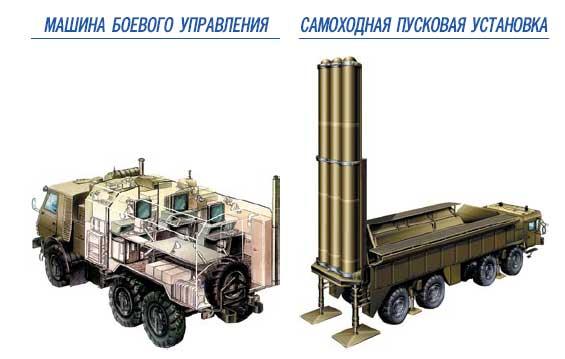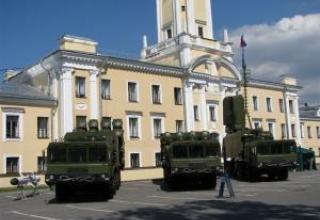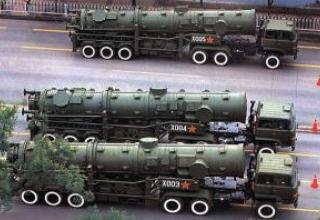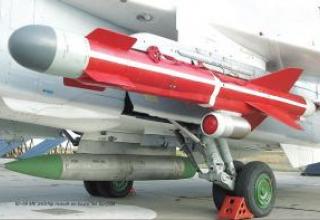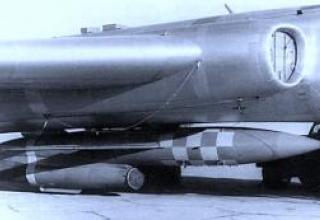Anti-ship cruise missile (SSCM) "Yahont" is designed to combat surface naval groups and single ships in conditions of strong firing and electronic countermeasures.
Works on creation of the fourth generation operational-tactical anti-ship complex began in the late 70's - early 80's in the NPO Mashinostroyeniya under the leadership of General Designer G. Efremov. Unlike the previous domestic RCDs, which have a relatively narrow "specialization" in terms of carriers, the new complex from the very beginning was conceived as a universal one: it was supposed to be placed on submarines, surface ships and boats, aircraft and coastal launchers. In terms of "universality", it was to surpass the foreign "record holder" in this field - the American PCR "Harpoon".
Distinctive features of the Yakhont rocket are:
- the range of fire over the horizon;
- full autonomy of combat use ("shot- forgotten");
- a set of flexible ("low", "high - low") trajectories;
- high supersonic speeds in all areas of flight;
- complete unification for a wide range of carriers (surface ships of all major classes, submarines and ground launchers);
- invisibility for modern radars (STELS technology).
Composition:
The rocket "Yakhont" (see the scheme) is made on the normal aerodynamic scheme with a trapezoidal folding wing and plumage. Aerodynamics of the glider in combination with high traction provides Yakhont with high maneuverability (maximum angle of attack - up to 150), allowing the missile to perform effective maneuvers to evade enemy's anti-missile defense.
The PKR propulsion system includes a marching supersonic direct-flow air jet engine (SFIRM) with an integrated solid propellant launch accelerator. The SHARD is designed for a 2.0-3.5 M high altitude marching range of 0 to 20,000 meters. The engine traction is 4,000 kgf, dry weight is 200 kg. The SPVRD air intake is a nose axisymmetric with a central cone.
In fact, the entire missile - from the frontal air intake to the nozzle cut - is an organically combined with the glider power unit. With the exception of the central air intake cone, which houses the control system units, the homing radar antenna and the combat unit, all internal volumes of the missile, including the direct-flow engine air path, are used for marching fuel and built-in solid propellant launch and acceleration stage.
After the missile leaves the launch container, a solid propellant upper stage is activated, which is installed on the "matryoshka" principle in the combustion chamber of the marching engine. A few seconds of its operation accelerate the missile to Mach 2 speed. Then the launcher switches off and is ejected from the marching engine by a raging air flow, and the Yacht continues to fly at a speed of 2.5M provided by a direct-flow liquid jet engine. The rocket is equipped with a combined guidance system (inertial on the marching section of the trajectory and active radar on the final stage of the flight).
The flight task (see diagram) is generated from data from an autonomous target designation source. The radar station (radar) of the homing head can capture a surface target of the "cruiser" class at a range of up to 75 km. After the initial target acquisition, the missile switches off the radar and performs a reduction to extremely low altitudes (about 5-10 m). As a result, the flight on the middle section is carried out under the lower boundary of the air defense zone. Later on, after the PKR leaves the radar due to the radio-horizon, the radar turns on again, captures and escorts the target on which the missile is guided. In this relatively short flight section, the supersonic speed of the Yacht makes it difficult for it to be hit by short-range air defense systems and to interfere with its homing head. Due to the short flight time and long range of the homing head, the Yakhont (see description of the CNS) does not impose strict requirements to the accuracy of target designation information.
An overview of the entire target position zone from high altitude creates conditions for pre-distributing missiles to group ships and selecting decoys. The main advantage of a Yahont missile is its targeting program, which allows you to act against a single ship on the principle of "one missile - one ship" or "flock" against a ship order. It is in the salvo that all of the complex's tactical capabilities are revealed. The missiles themselves distribute and classify by importance of the target, choose the tactics of attack and its plan. The autonomous control system includes not only data on counteracting the enemy's air defenses, but also methods of evading the fire of air defense equipment. Destroying the main target in the ship's group, the remaining missiles attack other ships warrant, eliminating the possibility of two missiles hitting the same target. To avoid errors in the choice of maneuver and defeat exactly the target in the onboard computer (BCVM) missiles laid electronic portraits of all modern classes of ships. In addition, the BCVM is a purely tactical information, for example, about the type of ships that allows you to determine who is in front of her - the convoy, aircraft carrier or landing party, and attack the main targets.
Early drawdown of the missile based on the care of the radio-horizon relative to the fired target ensures the failure of PCR escort by firing air defense systems, which, along with high supersonic speed and extremely low altitude of flight in the homing area dramatically reduces the possibility of intercepting PCR "Yahont" even the most advanced ship air defense.
The missile itself is enclosed in an airtight transport and launch container (TLC). The density of the layout is evidenced by the almost complete absence of gaps between the fuselage of the cruise missile and the inner surface of the TLC. The dimensions of the missile allows for two or three times the build-up of ammunition carriers of the same class.
Transport and launch container - an integral part of the missile. In TPK, being fully ready for combat use, the missile leaves the manufacturer, transported, stored and issued to the carrier. The technical condition of the missile and its systems is monitored without being removed from the container through a special board-connector.
The TIC with the missile is extremely unpretentious in operation, does not require liquid or gas supply and does not impose additional requirements on the microclimate at the storage sites and on the launchers. All this not only simplifies operation, but also ensures high reliability of the equipment, which is in "comfortable" conditions during the whole service life.
The use of TPK, a wide range of possible launch angles, a launch scheme that does not require the organization of jet stream gas removal allow the rocket to easily fit into the architecture of a wide range of carriers. And for this purpose launchers of various designs can be used. For example - extremely simple rack-type launchers designed for lightweight ships of "rocket boat - corvette" class, and modular vertical installation for surface ships of greater displacement - frigates, destroyers and cruisers (see the composition of the KASU). If the complex is installed on the upgraded ship, instead of one launch position of the "old" cruise missile it will be possible to install three PCR Yakhont containers. For example, in case of modernization of the boat project 1241 "Tarantul" instead of four missiles P-15 "Termite" can be installed 12 PCR "Yahont".
The Yakhont PCR can be used in the coastal mobile complex of K-300P Bastion anti-ship defense (see diagram). The Bastion Coastal Mobile Missile System (SIMM) with a Yakhont supersonic self-guided anti-ship missile (SHM) is designed to engage surface ships of various classes and types from landing units, convoys, ship and aircraft attack groups, as well as single ships and ground radio-contrast targets under conditions of intensive fire and electronic countermeasures. Bastion" MRBM with "Yakhont" provides protection: the coastline of more than 600 km from the enemy's landing operations, the far frontier of the political and administrative region as part of a unified system of its coastal defense.
The composition of the complex:
- PCR Yahont in the transport and launch glass;
- K-340P self-propelled launchers (SPU) on MZKT-7930 chassis (crew of 3 persons) (see photo);
- Combat control vehicle (MBU) K-380P on the KAMAZ-43101 chassis (crew of 5 persons);
- Information technology equipment for interfacing combat vehicles with the main command post;
- Automated combat control system (AMCS) for MANPADS;
- Maintenance facility complex (MACS). Additionally:
- K-342R transport and charging vehicles (TZM);
- Combat Duty Support Vehicles (MDCVs);
- Training Means (TMA);
- Target designation helicopter complex (TAC);
Maximum ammo of the complex: 36 PCR (12 SPU). The starting interval of the KR at volley firing from one SPU is 2-5 seconds. Time to put the complex on alert from a camping position < 5 min. Time of autonomous combat duty without auxiliary means - 24 hours (30 days with DAS). Assigned service life - 10 years.
The number of launchers, transport and charging vehicles and combat control vehicles within the complex can vary depending on the customer's wishes.
The aircraft version of the "Yakhonta" (see the scheme), while maintaining or slightly improving the main tactical and technical characteristics of the "ship-to-ground" version (maximum range 300 km, cruising speed range 2.0-2.6 M, maximum flight height up to 15 km) has a much smaller starting weight (2500 kg). The launch altitude from the carrier aircraft is up to 9000m, the start interval is 2-5s, the time of the complex readiness for firing is less than 4min, and the designated service life is 10 years. The air intake and the nozzle are closed with the fairings thrown down after the start (it is the bow fairing that distinguishes the aviation version from the ship one). All this reduces the aerodynamic resistance of PCR on the external suspension of the aircraft and allows you to arm new missiles aircraft of different classes. In particular, the Su-33 fighter can carry one Yakhont missile on its fuselage suspension. The Tu-142 long-range patrol aircraft can carry eight PCRs. In the latter case, its high salvo density enables it to deliver effective strikes against ship groups with powerful air defence.
Characteristics:
| Range of fire, km: - over a combined path - head over heels |
300 120 |
| Flight height, m: - on the march - all the way down - on target |
14000-15000 10-15 5-15 |
| Speed of flight: - at an altitude of 15km - all the way down |
750м/c (2.6М) 2.0М |
| Rocket length, mm (ship's version) | 8000 |
| Rocket length, mm (aviation version) | 6100 |
| Length of TIC, mm (aircraft version) | 8900 |
| Wingspan, mm | 1700 |
| Start weight , kg | |
| -aviation option | 2500 |
| -ship version | 3000 |
| Weight in TIC, kg | 3900 |
| Fighting unit | |
| Type | penetrating |
| Weight,kg | 200-250 |
| Homing Head -distance of action, km -angle of target acquisition, hail -readiness time, min -mass, kg |
up to 80 +/-45 2 89 |
| Preparedness of the complex for launch from the cold state of the carrier equipment, min | 4 |
| Interregular inspection time, year | 3 |
| Warranty period of operation, year | 7 |
Testing:
One of the first carriers of the complex is a multipurpose nuclear submarine of the project 885 "Ash", which belongs to the fourth generation of submarines. The keelmark in the series, called "Severodvinsk", took place on December 21, 1993. The boat carries 24 missiles in inclined launch shafts. The natural model of the new anti-ship missile in an export version (a variant for underwater, surface and shore-based), was first publicly demonstrated at the exhibition MAKS-97. It was also exhibited at MAKS-99.
The advertising passport for the small rocket ship of project 21632 "Tornado" (approved on 26.04.2008) indicates the possibility of placing the Yakhont complex as one of the weapon variants.
According to military analysts' forecasts, the Yakhont complex will have no analogues in the world for another 10 years. This can be proved by the interest expressed by foreign buyers. A number of countries of the Asia-Pacific region, the Middle East, which in the past bought Russian ships and boats with cruise missiles, have already become interested in the novelty of the domestic military industrial complex. PCR Yakhont also has good prospects in terms of upgrading foreign-built ships, where it can replace the Harpoon, Exocet, and Otomat anti-ship complexes.
Sources:
- А.В.Карпенко, С.М. Ганин "Отечественные авиационные тактические ракеты", "Бастион" N1, 2000г.
- НПО Машиностроения
- ОАО концен "Гранит-Электрон"



